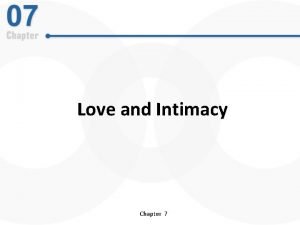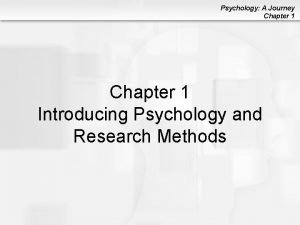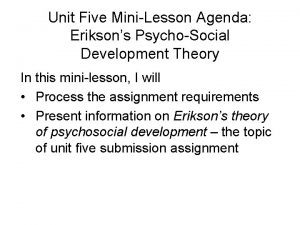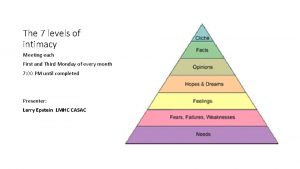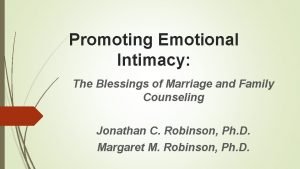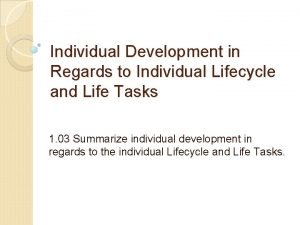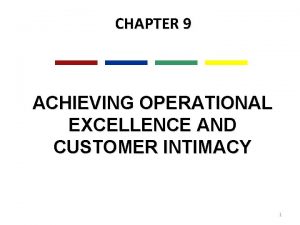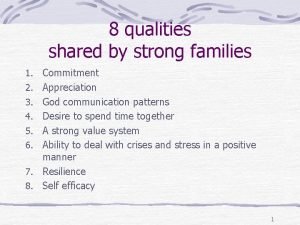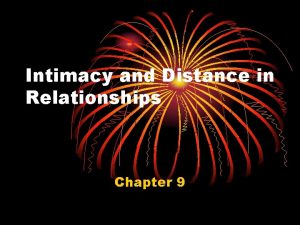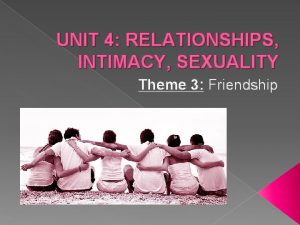Chapter 5 Friendship Affection Love Intimacy Copyright 2013






























- Slides: 30

Chapter 5: Friendship, Affection, Love, & Intimacy Copyright 2013 Pearson All Rights Reserved.

Get the Topic How Do Friendship, Affection, & Intimacy Affect Marriages & Families? What is Friendship? • Dyadic Relationship – a relationship between two people, that involves some kind of closeness or mutual affection • Characteristics of Friendship • Friendship vs. Love – Friendship is not usually as exclusive as love – Friendship doesn’t have the same amount of verbal & physical affection as love Copyright 2013 Pearson All Rights Reserved.

Get the Topic • Characteristics of Friendship Continued • True Friendship has Six factors – Respect – Trust – Responsiveness – the affectionate & supportive understanding of another’s needs, values, & desires – Capitalization – being sincerely happy about a friend’s well-being & success – Compare each other’s beliefs & skills ○ Social Comparison – the habit of evaluating one’s skills & qualities by comparing them to others – Social Support – the emotional, verbal, & material help received by others Copyright 2013 Pearson All Rights Reserved.

Get the Topic Friendship Through Life • Dyadic Withdrawal – the diminished involvement in outside social networks by a couple in a romantic relationship Copyright 2013 Pearson All Rights Reserved.

Get the Topic Friendship Through Life • Dyadic Withdrawal – the diminished involvement in outside social networks by a couple in a romantic relationship Copyright 2013 Pearson All Rights Reserved.

Get the Topic • Online & Offline Friendships • Majority of Friendships are maintained offline • Offline friendships characterized with more interdependence, depth, understanding, & commitment • Self-concept impacts online disclosure Copyright 2013 Pearson All Rights Reserved.

Get the Topic • Online & Offline Friendships Continued • Majority of Friendships are maintained offline • Offline friendships characterized with more interdependence, depth, understanding, & commitment • Most studies have not compared the quality of online with off -line relationships • Mixed-mode friendships: friendships which begin online and progress and continue to offline settings • The most important factor of online friendships is perceived similarity • Social attractiveness is the most important for offline and mixed-mode friendships Copyright 2013 Pearson All Rights Reserved.

Get the Topic • Same-Sex & Cross-Sex Friendships • Cross-Sex Friendships are more common today • Sex differences in relating to friends • Researchers agree that men and women can truly be friends • Benefits of cross-sex friendships • When one enters into a long-term relationship, crosssex relationships tend to decrease Copyright 2013 Pearson All Rights Reserved.

Get the Topic Hooking Up • Casual sexual activity with no strings attached between heterosexual people who are strangers or brief acquaintances • Early 2000 s hooking up was already a fairly common practice on US campuses • More common with people displaying extroversion or neuroticism – Neuroticism – a personality trait characterized by negative emotions such as depression, anxiety, anger, embarrassment, vulnerability, & impulsiveness Copyright 2013 Pearson All Rights Reserved.

Get the Topic Hooking Up • Hookups & Dates • Timing of Sex • Level of desire to “get to know” each other • Level of privacy • Level of gender equality – Yet still sigma in the form of sexual double standard ○ The unwritten code of behavior that allows greater sexual freedom to men than to women Copyright 2013 Pearson All Rights Reserved.

Get the Topic Hooking Up • Results of 2011 study • The number of students who “hook up” is increasing • The number of students who remain virgins is increasing as well • How do you think peer pressure affects sexual behavior in teenagers and young adults? Copyright 2013 Pearson All Rights Reserved.

Get the Topic What is Affection? • Physical Affection – the act of displaying affection through kisses, hugs, & physical contact • Verbal Affection – the act of displaying affection through compliments, assertions of love, laughter, etc. • Affection Exchange Theory – postulates that affectionate communication is an adaptive behavior that is instrumental to human survival & procreation Copyright 2013 Pearson All Rights Reserved.

Get the Topic Physical Affection • Has physiological & emotional benefits • Associated with higher relationship & partner satisfaction • Verbal Affection • Can be expressed in a variety of ways • Style is influenced by gender roles & homophobia – Homophobia – the irrational fear of homosexuals • Copyright 2013 Pearson All Rights Reserved.

Get the Topic What is Intimacy? • Autonomy & Intimacy • Intimacy – a feeling of closeness in meaningful relationships characterized by sharing of persona experiences, thoughts, & emotions – Purpose is to establish trust • Autonomy –a state of independence & selfdetermination • Both necessary in any healthy relationship Copyright 2013 Pearson All Rights Reserved.

Get the Topic • Theories of Intimacy • Dialectic Approach – the relationship model according to which relationships are characterized by an ongoing tension between intimacy & autonomy • Attachment Theory – theory that states that people’s patterns of attachment are shaped by the intimate bonding they shared with the caregivers during intimacy • Social Exchange Theory – the sociological perspective arguing that satisfaction in a relationship is enhanced when the rewards are greater than the costs Copyright 2013 Pearson All Rights Reserved.

Get the Topic Theories of Intimacy Continued • Circumplex Model – a graphic model identifying three characteristics of a balanced family system – Family cohesion – Flexibility – Communication • Intimacy & Gender • Women tend to disclose more than males • Girls tend to develop more intimate friendships • Boys tend to focus on physical activities • Copyright 2013 Pearson All Rights Reserved.

Copyright 2013 Pearson All Rights Reserved.

Get the Topic Love Three components • Emotional – enjoyment, caring, admiration, respect, & passion • Cognitive – expectations & decisions • Behavioral – behaviors adopted to express love • The Influence of Culture & Gender • Countries with individuality important, love = passion • Men love “passionately”; women love “compassionately” • Copyright 2013 Pearson All Rights Reserved.

Get the Topic Love Continued • Sexual Orientation, Racial Differences, & Love • Love is influenced by societal forces – Societal Forces – influences coming from or relating to society • Percentage of long-term homosexual relationships is very high • African Americans tend to marry less & divorce more than Caucasian Americans – Also, African Americans tend to be more assertive & less neurotic than Caucasian Americans Copyright 2013 Pearson All Rights Reserved.

Get the Topic Love Continued • Sexual Orientation, Racial Differences, & Love • The 2010 U. S. Census reports that over 130, 000 same -sex couples say they are married • The number of same-sex partners has more than doubled since the 2000 U. S. Census • Chaz Bono and transgendered families • Researchers state that sexual orientation and gender identities have almost nothing to do with love, relationships and family roles Copyright 2013 Pearson All Rights Reserved.

Get the Topic General Theories of Love • The Color (Styles) of Love Copyright 2013 Pearson All Rights Reserved.

Get the Topic General Theories of Love Continued • The Prototype Approach • When researchers create a theory of love by gathering the opinions, beliefs, & feelings of people toward love • Maternal love was rated as the best example of prototypical love • Lowest ratings for infatuation, sexual love, & puppy love • Similar approach helped determine the main qualities of love – trust, caring, honesty, friendship, respect, consideration, loyalty, & commitment Copyright 2013 Pearson All Rights Reserved.

Get the Topic Passionate Love vs. Companionate Love • Passionate Love – characterized by overwhelming passion & emotional attachment – Usually starts suddenly & is characterized by idealization ○ Idealization – an unrealistic view of the loved one • Companionate Love – characterized by feelings of trust & friendship & enjoyment of each others’ company • Unlike passionate love, companionate love is always considered a positive experience Copyright 2013 Pearson All Rights Reserved.

Get the Topic How to Increase Love in Your Relationships • Love is a mutable feeling that ebbs & flows • Start an open conversation about your ideas of relationships • Get to know your own needs & express them clearly • Act as a team • When confused, disappointed, or angry, speak up & be ready to negotiate • View your relationship as a living thing with its ups & downs Copyright 2013 Pearson All Rights Reserved.

Copyright 2013 Pearson All Rights Reserved.

Think Marriages & Families What are the Theories Behind Love in Marriages & Families? • Functionalism • Monogamy contributes to the social order • Conflict Theory • Love is influenced by having power • Symbolic Interactionism • Couples & family use symbols to represent their idea of love • Love is taught through rituals – Rituals – prescribed sets of actions often connoted by symbolic value & usually adopted by religious & social groups through history Copyright 2013 Pearson All Rights Reserved.

Copyright 2013 Pearson All Rights Reserved.

Copyright 2013 Pearson All Rights Reserved.

Copyright 2013 Pearson All Rights Reserved.

Discover Marriages & Families in Action How Can Couples Address Intimacy Problems? Copyright 2013 Pearson All Rights Reserved.
 3 loves in your life
3 loves in your life Love love jesus is love god greatest gift lyrics
Love love jesus is love god greatest gift lyrics Copyright 2013
Copyright 2013 Love relationship and friendship goes everywhere
Love relationship and friendship goes everywhere Triangluar theory of love
Triangluar theory of love True friendship comes when the silence between
True friendship comes when the silence between Verbal affection
Verbal affection Loyalty spaarsysteem
Loyalty spaarsysteem Strong affection
Strong affection The neurotic need for affection and approval
The neurotic need for affection and approval Head strokes physical affection
Head strokes physical affection For a moment the last sunshine fell
For a moment the last sunshine fell Not laughing out loud candy
Not laughing out loud candy Set your affections on things above
Set your affections on things above Bar games for adults
Bar games for adults Operational definition in psychology
Operational definition in psychology Sample of lacreous affection
Sample of lacreous affection Ald hors liste
Ald hors liste Trust vs mistrust maladaptation
Trust vs mistrust maladaptation Intimacy levels
Intimacy levels Emotional intimacy
Emotional intimacy Love triangle theory
Love triangle theory Anal personality
Anal personality Intimacy vs isolation
Intimacy vs isolation Erikson despair
Erikson despair Sahabat nestle reward
Sahabat nestle reward Customer relationship management and customer intimacy
Customer relationship management and customer intimacy Customer relationship management and customer intimacy
Customer relationship management and customer intimacy Be content
Be content Intimacy and passion without commitment
Intimacy and passion without commitment Erikson stage intimacy vs isolation
Erikson stage intimacy vs isolation
